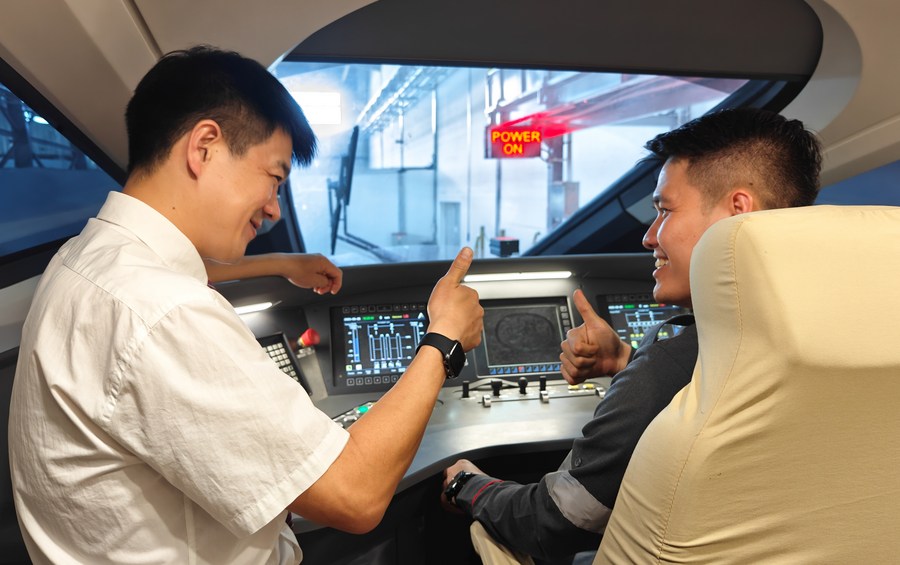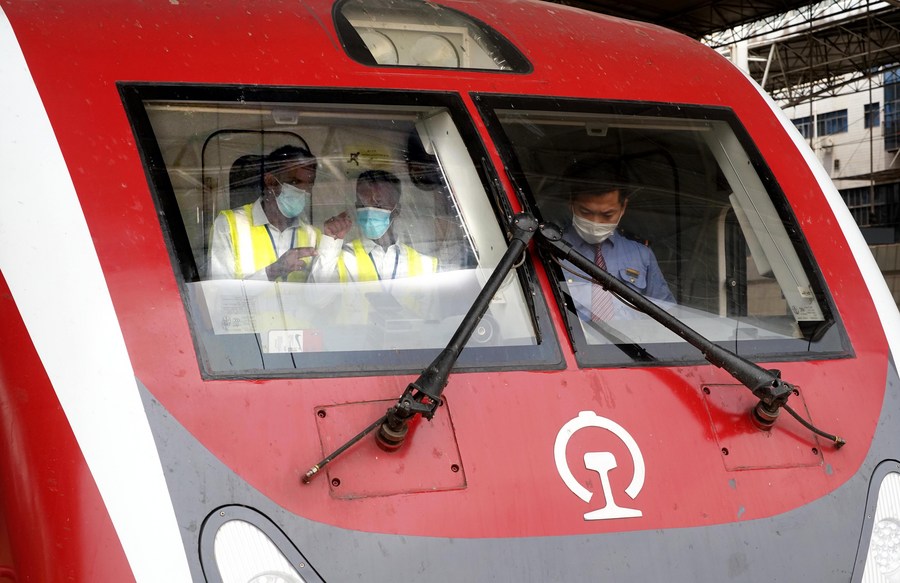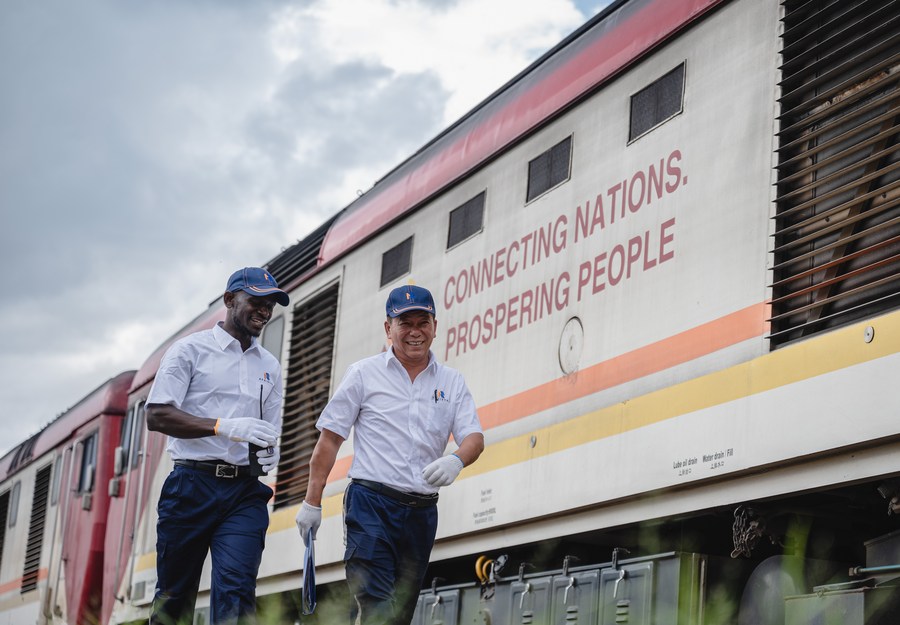




- BRNN
- BRI News
- BRNN News
- Database
Official Documents Polices and Regulations
Inter-government Documents International Cooperation BRI Countries
Business Guide Economic Data BRI Data
Trade
Investment Projects Latest projects
Cases - Content Pool
* China has been involved in the construction of over 6,000 kilometers of railways, 6,000 kilometers of roads and more than 80 large power facilities in Africa over the past decade, according to official data.
* Over the past decade, more than 421,000 local jobs were created globally under Belt and Road cooperation. According to a World Bank report, Belt and Road projects could help lift 7.6 million people from extreme poverty and 32 million from moderate poverty worldwide by 2030.
BEIJING, Oct. 7 (Xinhua) -- Driving a train that runs 350 kilometers per hour was once unimaginable for Wawan Setiawan, an Indonesian freight train driver with 10 years of experience. But now he is on track to be among the first high-speed train drivers in his country and, more broadly, Southeast Asia.
In 2020, when the China-Indonesia joint venture tasked with building the Jakarta-Bandung High-Speed Railway began recruiting train drivers, Wawan rushed to apply.
"Technology, operation, safety methods -- everything I learn is new and exciting," said Wawan, who has been receiving training from Chinese high-speed train drivers ever since.

This aerial photo taken on Sept. 30, 2023 shows a high-speed electrical multiple unit (EMU) train of the Jakarta-Bandung High-Speed Railway running in Purwakarta, Indonesia. (Xinhua/Xu Qin)
"MY LIFE SPED UP"
Mu Zhen, Wawan's driving practice mentor, is the Chinese train driver for the Jakarta-Bandung High-Speed Railway, which links Indonesia's capital with its fourth-largest city.
In an operation simulator, Mu told Wawan to ease as the Indonesian driver's right hand tightly gripped the speed control handle. "Tension may lead to misoperation as the handle has high sensitivity," Mu detailed the reason and guided Wawan to try again.
"I am excited to mentor Indonesian train drivers and happy to share my skills without reservation. I'm learning Indonesian to overcome language barriers," said Mu.
Mu arrived in Indonesia last October and has been preparing for the operation of the railway line. "The Jakarta-Bandung High-Speed Railway was built with Chinese standards and technology, so driving the high-speed train here feels the same as in China," said Mu.

A Chinese instructor (L) interacts with an Indonesian train driver on a train at a maintenance workshop of the Tegalluar Station in Bandung, Indonesia, Aug. 25, 2023. (Xinhua/Xu Qin)
A landmark project under the China-proposed Belt and Road Initiative, the 142-kilometer Jakarta-Bandung High-Speed Railway cuts the journey between the two cities from over three hours to roughly 40 minutes.
"The development of a high-speed railway will encourage a bigger economy because it will support faster mobility," said Wawan, adding that he hopes the high-speed railway can be extended to Surabaya, Indonesia's second-largest city and seaport.
"I studied hard and did my best to ensure that I could become one of the first high-speed train drivers in Indonesia and Southeast Asia," said Wawan.
"If life is a train that runs on a track, then my life just got sped up -- super fast, super exciting and full of hope," he said.
"FISH ON THEIR OWN"
China has been building rails, ports and other infrastructure with countries under Belt and Road cooperation that have helped boost regional connectivity and create jobs for locals.
The Lao section of the China-Laos Railway, launched in December 2021, has created more than 110,000 jobs. Twenty-four-year-old Sida Phengphongsawanh is one of them.
Sida became a train inspector at the China-Laos Railway Vientiane Operation Management Center in 2021 after studying electric automation in China for four years and receiving training in Chinese and railway knowledge at the Confucius Institute in Laos.
"The mentors here have been so patient since my internship. Because it was the first time we touched real trains, everything was new to us, and they taught us step by step in a patient way," she said.
Fifty-eight-year-old Wen Bin, Sida's Chinese mentor, has worked in Laos since October 2011. He said the Chinese personnel would ensure local staff members like Sida could work independently long after their Chinese colleagues left.
"We are recruiting new local personnel. Not many speak Chinese, so I hope Sida and her fellow colleagues can take up the responsibility of using their own language to teach the new generation," said Wen.

Lao staff members perform at the first cross-border passenger train from Kunming in southwest China's Yunnan Province to the Laotian capital Vientiane on April 13, 2023. (Xinhua/Xing Guangli)
In East Africa, 28-year-old Anketsebrhan Girma had long dreamed of becoming a pioneer modern train driver in her country, Ethiopia. She achieved her dream by persevering through intense competition before joining the Ethiopia-Djibouti Standard Gauge Railway Share Company in 2018 after graduating from university, eventually becoming Ethiopia's first female electrified train driver.
She is now an assistant train driver for the Ethiopia-Djibouti Railway, which connects the Ethiopian capital, Addis Ababa, to the Red Sea port of Djibouti.
Since July, Girma and 27 colleagues have undergone a six-month training program in the central Chinese city of Zhengzhou. They are the second batch of Ethiopian trainees to enroll at the Zhengzhou Railway Vocational and Technical College.
The first batch of 34 trainees have entirely commanded the skills of driving, monitoring, checking and maintaining electrified trains after eight months of practical training in 2020 and are now capable of independently driving an electrified train. After returning home, they quickly became the backbone of the Ethiopia-Djibouti Railway.
One of the 34 trainees, Dejen Gezu, is now tasked with driving and training young colleagues. "I know everyone currently in China receiving the training, particularly Anketsebirhan Girma, the only female train driver we have," he said.
"I dreamed of driving the train independently like Gezu after studying in China," Girma said.
Abdi Zenebe, chief executive officer of the Ethiopia-Djibouti Standard Gauge Railway Share Company, said that during the construction and operation of the Ethiopia-Djibouti Railway, Chinese experts have trained about 3,000 local professionals on railway techniques.
"The philosophy and principles of our Chinese colleges are in line with Chinese values ... The idea is not to give someone fish, but rather how to teach someone how to fish," Zenebe said, referring to an ancient Chinese saying.

Ethiopian staff members Yidnekachew (2nd, L) and Taressa (1st, L) prepare before their internship starts in Zhengzhou, central China's Henan Province, June 5, 2020. (Xinhua/Li An)
GAME CHANGER
China has been involved in the construction of over 6,000 kilometers of railways, 6,000 kilometers of roads and more than 80 large power facilities in Africa over the past decade, according to official data.
The 752-kilometer Ethiopia-Djibouti Standard Gauge Railway, launched in October 2016, is Africa's first electrified transboundary railway. It has cut transportation time for goods from more than three days to less than 20 hours and reduced costs by at least one-third, substantially facilitating the imports and exports of this landlocked country.
"As Ethiopia has no sea or port, it used to take a few days to deliver goods to and from Djibouti by road. The Ethiopia-Djibouti Railway has greatly reduced time and costs. It is like the backbone of our country," said Girma.
In neighboring Kenya, the 480-kilometer Mombasa-Nairobi Standard Gauge Railway (SGR), launched in mid-2017, connects the country's capital city with its eastern port. It has cut travel time by half, from an average of ten hours on the century-old meter-gauge railway to approximately five hours, boosting the movement of people and cargo.
A supervisor at the rolling stock department of the Mombasa-Nairobi Railway, Lawrence Pius Murithi, is proud to have a prized career that has eluded most of his peers.
"I was lucky to be chosen to join the SGR for the maintenance of passenger trains," said the 32-year-old mechanical engineering graduate, adding that he has sharpened his technical and managerial skills over the last six years since joining the growing ranks of local youth working for the rail.
His finances have been improved thanks to a decent monthly salary, enabling him to purchase land in his native village and run a livestock business as a side hustle.
"Working for the SGR has improved my living status, and I look forward to furthering my education to be in the company's top management," he said.

Chinese instructor Jiang Liping (R) and apprentice Horace Owiti walk past a train carriage on the Mombasa-Nairobi Railway in Nairobi, Kenya, May 23, 2023. (Xinhua/Wang Guansen)
In Laos, the only landlocked country in Southeast Asia, the 1,035-kilometer China-Laos Railway has helped the country become a transportation hub on the Indo-China Peninsula.
The rail links the Lao capital, Vientiane, with the southwestern Chinese province of Yunnan, with a design speed of 160 kilometers per hour for the Lao section.
"Friends in my hometown told me that travel has become convenient. It used to take 10 hours from my hometown to Vientiane, but now it takes only three hours with the railway," said Sida, the train inspector.
One-hundred and fifty-two countries and 32 international organizations have signed cooperation documents with China under the Belt and Road Initiative, proposed in 2013.
Over the past decade, more than 421,000 local jobs were created globally under Belt and Road cooperation. According to a World Bank report, Belt and Road projects could help lift 7.6 million people from extreme poverty and 32 million from moderate poverty worldwide by 2030.
"The Belt and Road is a great initiative," Sida said, "and I think the China-Laos Railway is just the starting point (in the region). It will connect more countries in the future, allowing us to go abroad more easily."

Tel:86-10-65368972, 86-10-65369967